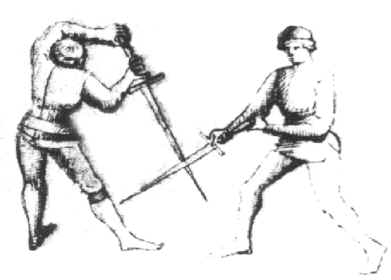 The
Myth of Edge-On-Edge Parrying in Medieval Swordplay The
Myth of Edge-On-Edge Parrying in Medieval Swordplay
By John Clements
Some may consider the so-called
“edge versus flat parry debate” to be a non-issue
and merely beating a dead horse. I disagree. Considering
the frequency by which the question is still raised and
the countless examples of edge-on-edge blocking found within
stage combat, as well as the ubiquitous examples provided
everywhere from modern saber fencing to sport kendo and
even Star Wars light-sabers, the issue is more an undead
zombie horse perpetually rising from the grave.
Many historical fencing enthusiasts do not grasp the concepts of
parrying against cuts with cutting swords as described in numerous Medieval and
Renaissance fighting manuals. These texts
teach the concept of defending by counter-striking or by receiving blows on the flat
portion of the blade. As will become clear, edge-on-edge
parrying was not taught as doctrine. In fact,
defense, or warding of cutting blows, is described in many ways in 15th century
fencing texts by many masters and never as a direct resistant block of deliberate
opposition of sharp edge on sharp edge (so common in stage-combat and sport fencing and
derived from 18th and 19th century methods of swordplay).
There is a tremendous, if not outright complete, lack of any support
for doing so that can be found within any of the source literature (at least prior to the
17th century). While in contrast,
all the assorted fighting manuals on long-swords which we have make it quite clear how to
defend against cutting attacks by using intercepting and redirecting counter-blows, or
else by covering so that cuts land upon the flat (not edge) of the blade. As we will see, it isn’t any clearer than
that.
In much of my previous writings on this very subject I have tried to
offer an amalgam instruction using a distillation of teachings from various historical
sources. Parries in Medieval fencing are not those of either rapier fighting or later
forms of European swordplay. This
is probably why, despite hundreds upon hundreds of illustrated pages of longsword fencing,
the source manuals show nothing like the direct edge parries depicted and described so
clearly in much later fencing styles. However some enthusiasts remain
unconvinced, and this generalized approach is no longer justifiable. More specific citations and description on
parrying from the historical manuals is thus called for.
Without going into great detail here, I will try to offer a small portion of this
large volume of often ignored and misinterpreted evidence. [without footnotes or endnotes
in this online version]
I’ve described elsewhere before how defending against cuts was
done essentially:
- By voiding blows
through dodging
- By deflecting
blows by hitting them
- By stepping in to
stifle them, or by receiving them on the flat
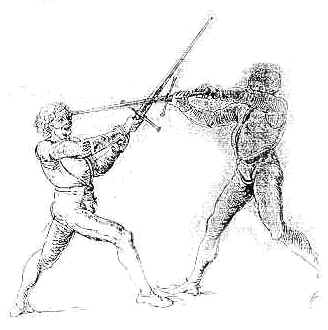 Parries can
be defined as the deflecting or deviating of the opponent's
blade before it reaches its target. With Medieval and Renaissance
cutting swords this was primarily achieved not by
receiving it so that it impacts your own weapon (especially
on its edge), but by hitting or beating at the oncoming
weapon to knock it off line and away. The difference is one of defense by counter-striking rather
than a rigid blocking or direct obstruction of their sharp
edge with yours. Doing
the latter not only leaves you vulnerable and less able
to attack, but damages your sword so that it will cut poorly
and it produces stress and fracture lines that will eventually
cause it to break. Parries can
be defined as the deflecting or deviating of the opponent's
blade before it reaches its target. With Medieval and Renaissance
cutting swords this was primarily achieved not by
receiving it so that it impacts your own weapon (especially
on its edge), but by hitting or beating at the oncoming
weapon to knock it off line and away. The difference is one of defense by counter-striking rather
than a rigid blocking or direct obstruction of their sharp
edge with yours. Doing
the latter not only leaves you vulnerable and less able
to attack, but damages your sword so that it will cut poorly
and it produces stress and fracture lines that will eventually
cause it to break.
Nowhere in the Medieval German fencing
manuals do we encounter words that mean parry or block as
it is defined in later fencing. Rather, we find the word
“displace”, Versetzen, as in intercepting
and deflecting attacks. While in the Medieval Italian
manuals we see similar terms (for example, coverta or
“covering”) meaning essentially, deflection, redirection,
and protection.
In his systematic work of 1410, Flos Duellatorium in Armis
(“Flower of Battle”) the Italian master, Fiore Dei Liberi, offered no evidence
of any edge-on-edge blocking of cuts for his method of defending with the long-sword. All his parare’ (“parries”)
as we will see, are counter-strikes. In
Master Fiore’s system he described impaze as any defensive action to impede,
stifle, or bind the opponent’s blade before their blow is completed. While he called any counter-technique used
as a defensive action, a Remedio (i.e., a remedy) or Contrario.
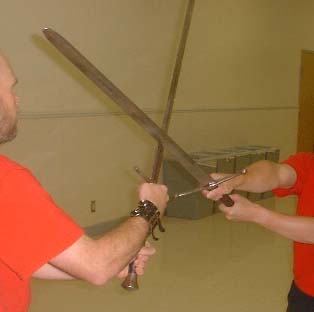 The
later Italian master Filippo Vadi declared, “The art of the sword consists only in crossing,
putting both strikes and thrusts in their right place”
(Chapter 3, Doctrine of the Sword, Liber de Arte Gladiatoria Dimicandi,
c. 1480). Vadi makes no mention of opposition
blocking of edge blows and like Fiore before him writes
expressly to parry a blow with another blow (striking to
deflect), even stating that “blows are used to defend” on
“both the left and right”.
In the works of both Fiore and Vadi we find the parata
di croce or “cross parry” as a counter-strike
which defends against the opponent’s blow by hitting
their blade on its forte. Yet, what must be understood is
that this blow is made with the defender's edge on the flat
of the attacker’s blade. Of course, as stated earlier,
the ideal “defense” is where you can simultaneously
avoid an attack and return a blow at the inherent opening
the opponent creates by his own attack.
This is something best understood by observing competent
fencers performing it live. The
later Italian master Filippo Vadi declared, “The art of the sword consists only in crossing,
putting both strikes and thrusts in their right place”
(Chapter 3, Doctrine of the Sword, Liber de Arte Gladiatoria Dimicandi,
c. 1480). Vadi makes no mention of opposition
blocking of edge blows and like Fiore before him writes
expressly to parry a blow with another blow (striking to
deflect), even stating that “blows are used to defend” on
“both the left and right”.
In the works of both Fiore and Vadi we find the parata
di croce or “cross parry” as a counter-strike
which defends against the opponent’s blow by hitting
their blade on its forte. Yet, what must be understood is
that this blow is made with the defender's edge on the flat
of the attacker’s blade. Of course, as stated earlier,
the ideal “defense” is where you can simultaneously
avoid an attack and return a blow at the inherent opening
the opponent creates by his own attack.
This is something best understood by observing competent
fencers performing it live.
Like
the various German masters, Filippo Vadi described three
essential types of parare’. One type is to strike off their
attack with a fendente blow (downward cut). The second,
and more challenging, is to do the same when striking upward
by raising the sword from a low position and “crossing”
their weapon. His third type of parry is made
against thrusts or downward cuts by hitting them with a
horizontal sideways blow. Vadi also described the use of
half-swording (mezza spada) techniques as a form
of “crossing” parry by closing-in to suppress
the opponent’s strike. Like Fiore, whose work influenced him,
Vadi instructed that with the long-sword you should make parries
with a fendente (downward blow). This makes perfect sense. Such an action is in keeping with
nearly identical German conceptions of counter-striking. Whether
to a vertical cut at the head, a diagonal cut at the collar
or arms, a horizontal one to the mid-section, or even a low
cut to the knee or shin, all of these attacks can be warded
with a forceful downward counter blow. In this manner, neither of the
defender’s own edges strikes the opponent’s edge,
but rather hit at an angle on his flat (or even vice versa,
your flat against his edge).
Again, seeing this demonstrated with steel blades and
quick, powerful strikes is entirely convincing.
For defense, Vadi also
stressed the concept of mezzo tempo (“half time”) blows. These were
counter-attacks (typically to the hand or arm) thrown in the middle of the opponent’s
attack. When we consider his instructions
carefully, we can reasonably understand there is really no other way such counter-strike
“parries” could be executed other than in the middle of the opponent's
action. Throwing them either before or after
their strike would not be a parry at all but rather a preemptive or a follow-on strike. Again, his method is consistent with the defense
teachings of the German masters. Vadi did however, also
say that left to right upward cuts should all be made as false/back edge blows–which
when thrown in proper timing would also deflect an opponent’s own strikes by hitting
them aside upon their flat.
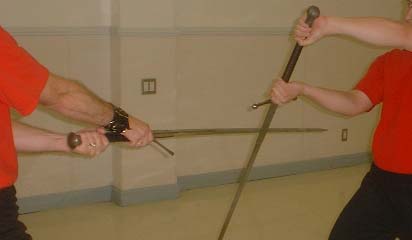 In
his commentaries from the early 1400s on the grand Fechtmeister,
Johannes Liechtenauer’s late 14th century
Fechtbuch, Sigmund
Ringeck taught, “Beware the parries which only poor
swordsmen use” or “Beware of those show-fighters
who parry and fight using wide, sweeping motions”.
Following Liechtenauer, Ringeck described the four
techniques of Versetzen or Versatzung (“displacement”
or “to displace”).
As opposed to an opposition block, this is the concept
of a defensive action to put off an attack by a deflecting
blow or counter strike employed with evasive stepping. Fechtmeister Ringeck stated, “you
shall get to know the four displacements, which are four
strikes”. Abwenden
and Absetzen are
two examples of Versetzen. Absetzen was the principle of timed counter attack to deflect
a thrust or parry a cut. Essentially, you put the attack
aside by a small deflecting motion. Ringeck described the
Absetzen or Absezen (“setting aside”) as being: “You
shall learn how to set aside strikes and thrusts skillfully,
so that his thrust is ‘broken’ and yours hits.” This simultaneous parry and riposte
is the whole idea of Abnemen, or intercepting attacks with your weapon.
These ideals on defense permeate all the Medieval German fencing
texts. Fiore dei Liberi used
the term rebatter (or rebatir) to
mean essentially the same thing as Absetzen.
Abwenden, or “warding off”, in contrast,
can mean a parry by literally striking against the attacking
blow to hit it away, but in a manner where your own strike
continues on to hit the opponent. In
his commentaries from the early 1400s on the grand Fechtmeister,
Johannes Liechtenauer’s late 14th century
Fechtbuch, Sigmund
Ringeck taught, “Beware the parries which only poor
swordsmen use” or “Beware of those show-fighters
who parry and fight using wide, sweeping motions”.
Following Liechtenauer, Ringeck described the four
techniques of Versetzen or Versatzung (“displacement”
or “to displace”).
As opposed to an opposition block, this is the concept
of a defensive action to put off an attack by a deflecting
blow or counter strike employed with evasive stepping. Fechtmeister Ringeck stated, “you
shall get to know the four displacements, which are four
strikes”. Abwenden
and Absetzen are
two examples of Versetzen. Absetzen was the principle of timed counter attack to deflect
a thrust or parry a cut. Essentially, you put the attack
aside by a small deflecting motion. Ringeck described the
Absetzen or Absezen (“setting aside”) as being: “You
shall learn how to set aside strikes and thrusts skillfully,
so that his thrust is ‘broken’ and yours hits.” This simultaneous parry and riposte
is the whole idea of Abnemen, or intercepting attacks with your weapon.
These ideals on defense permeate all the Medieval German fencing
texts. Fiore dei Liberi used
the term rebatter (or rebatir) to
mean essentially the same thing as Absetzen.
Abwenden, or “warding off”, in contrast,
can mean a parry by literally striking against the attacking
blow to hit it away, but in a manner where your own strike
continues on to hit the opponent.
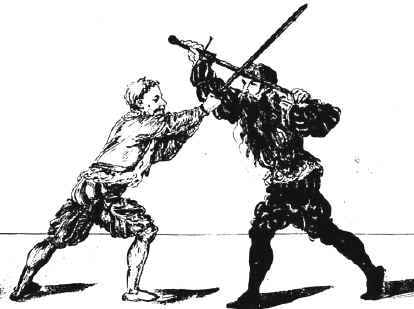 Despite
what some enthusiasts imagine they see, there are also no
edge-on-edge blocks in the various editions of Hans Talhoffer’s
fencing texts (c.1443-1467). As researcher-practitioner Mark
Rector notes in his modern version of the 1467 Talhoffer
Fechtbuch, “Talhoffer never shows anything resembling
static, blade on blade blocks. His setting aside techniques
are fluid and dynamic, and naturally lead into counter-attacks.”
(p. 12). In its section on the Langenmesser
(“large knife”), the Von Bauman version of the
mid 15th century Codex Wallerstein more than
once specifically instructs to defend by setting aside blows
mit der flech (or mit de Flache)
– that is literally, “with the flat”.
For example, plate 65 of the Codex instructs: “If
he blows you, deflect with your messer to the side with
your flat and on your crosspiece”, while plate 69 states:
“one blows you in your head, so set aside with your
flat and on your crosspiece, and push his messer on the
side”. As modern translator
and researcher Grzegorz
Zabinski points out, “Although the phrase
versecz mit der kurczen
sneid ("deflect with the short edge") appears
in the [Codex Wallerstein plates 9, and 10] …it should
be understood as deflecting done on the opponent’s
flat performed with one's own edge, although one cannot
exclude an accidental edge-to-edge contact there.”
(Zabinski, p. 5). Other instructions in the
Codex teach to deflect downward cuts by receiving a stroke
on the blade while holding your weapon at half-sword, something
only possible by taking the impact on the flat.
Explicitly clear examples of this can be found illustrated within several
manuals. Despite
what some enthusiasts imagine they see, there are also no
edge-on-edge blocks in the various editions of Hans Talhoffer’s
fencing texts (c.1443-1467). As researcher-practitioner Mark
Rector notes in his modern version of the 1467 Talhoffer
Fechtbuch, “Talhoffer never shows anything resembling
static, blade on blade blocks. His setting aside techniques
are fluid and dynamic, and naturally lead into counter-attacks.”
(p. 12). In its section on the Langenmesser
(“large knife”), the Von Bauman version of the
mid 15th century Codex Wallerstein more than
once specifically instructs to defend by setting aside blows
mit der flech (or mit de Flache)
– that is literally, “with the flat”.
For example, plate 65 of the Codex instructs: “If
he blows you, deflect with your messer to the side with
your flat and on your crosspiece”, while plate 69 states:
“one blows you in your head, so set aside with your
flat and on your crosspiece, and push his messer on the
side”. As modern translator
and researcher Grzegorz
Zabinski points out, “Although the phrase
versecz mit der kurczen
sneid ("deflect with the short edge") appears
in the [Codex Wallerstein plates 9, and 10] …it should
be understood as deflecting done on the opponent’s
flat performed with one's own edge, although one cannot
exclude an accidental edge-to-edge contact there.”
(Zabinski, p. 5). Other instructions in the
Codex teach to deflect downward cuts by receiving a stroke
on the blade while holding your weapon at half-sword, something
only possible by taking the impact on the flat.
Explicitly clear examples of this can be found illustrated within several
manuals.
A 1555
edition of Der Alten Fecter an fengliche Kunst (“The Original Art of the
Ancient Fencers”), a Fechtbuch compilation by Christian Egenolph, instructed that
with a longsword from the middle position of the Pflug (“plough”) guard
you should “displace
quickly with the flat so that his sword slips down”.
Thus, the very posture of the Pflug guard is itself a parrying
position. The same can be said of the Ochs
(“Ox”) posture, called Finestra ("Window") in Italian.
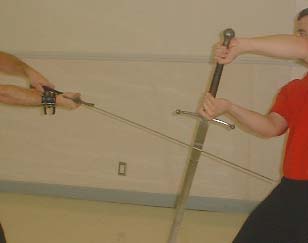 According
to Egenolph’s material, the high or “roof”
guard of Von Tach (Vom Dach) is
described as a deflecting counter-strike made from the low Eisern
Pforten (“Iron
Door”): “If
somebody strikes at you from above take his blow from above
with the short edge then step and strike with the true edge.”
By this it means a rising reverse strike that knocks
the opponent’s blade out of the way before coming back
down to hit them (Vadi’s Rota
is a similar technique).
When
done correctly, the angle it is delivered on will allow
it to impact edge on flat. At
one point the text states that if the opponent strikes from
up high impetuously (like a Püffel, or “buffalo”), you should then “displace
quickly, so that his sword slips down on the flat of your
blade”. It
further adds, “If you could not hit him, move your
pommel upward and you are protected, too. Let his sword
slip down as well and use your advantages.” Such slipping cannot occur in
this manner if the edge is used to receive a blow in this
“hanging position”. The
longsword material from Egenolph’s Fechtbuch compilation
also described the application of the Hangend Ort (“hanging
point” position), the
text states:
“To execute the hanging guard put the right foot in
front, step with the flat of the blade under the face, displace
strikes from above short and high, let [it] run down your
blade and make a long step with a strike.” The instructions make clear that the attacker’s blow is
to be received on the flat of the blade as part of a counter-cut. According
to Egenolph’s material, the high or “roof”
guard of Von Tach (Vom Dach) is
described as a deflecting counter-strike made from the low Eisern
Pforten (“Iron
Door”): “If
somebody strikes at you from above take his blow from above
with the short edge then step and strike with the true edge.”
By this it means a rising reverse strike that knocks
the opponent’s blade out of the way before coming back
down to hit them (Vadi’s Rota
is a similar technique).
When
done correctly, the angle it is delivered on will allow
it to impact edge on flat. At
one point the text states that if the opponent strikes from
up high impetuously (like a Püffel, or “buffalo”), you should then “displace
quickly, so that his sword slips down on the flat of your
blade”. It
further adds, “If you could not hit him, move your
pommel upward and you are protected, too. Let his sword
slip down as well and use your advantages.” Such slipping cannot occur in
this manner if the edge is used to receive a blow in this
“hanging position”. The
longsword material from Egenolph’s Fechtbuch compilation
also described the application of the Hangend Ort (“hanging
point” position), the
text states:
“To execute the hanging guard put the right foot in
front, step with the flat of the blade under the face, displace
strikes from above short and high, let [it] run down your
blade and make a long step with a strike.” The instructions make clear that the attacker’s blow is
to be received on the flat of the blade as part of a counter-cut.
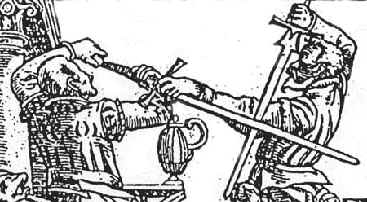 A
significant amount of evidence for defense by counter-blow
and deflection in medieval fencing as well as for the use
of the flat over edge comes to us from Joachim Meyer’s
immense fighting treatise of 1570. Like earlier German masters, Meyer
emphasized that the standard defensive action was Austretten
(“stepping out”) –the action of moving away
and voiding oncoming blows by either reverse or traversing
steps. In his Chapter 5 on parries, Meyer
referred to the traditional methods of Versatzung
(displacement) as being Absetzen (“setting aside”)
a counterblow with the true edge to knock the opponent’s
sword out of the way; and Abwenden (“warding
off”) as a cut that simultaneously deflects and counterattacks
in the same action. Meyer also noted which specific
strikes were used to ward off attacking blows, stating the
diagonal Zornhaw cut, the horizontal Mittelhaw,
and the diagonal rising Underhaw
(if delivered powerfully with a step forward) could all
be used to set off high descending blows. Meyer also noted
that the Scheitelhau (vertical downward cut) with
the true edge was itself a common opening attack that itself
could also be used to ward off diagonal, horizontal and
rising cuts. A
significant amount of evidence for defense by counter-blow
and deflection in medieval fencing as well as for the use
of the flat over edge comes to us from Joachim Meyer’s
immense fighting treatise of 1570. Like earlier German masters, Meyer
emphasized that the standard defensive action was Austretten
(“stepping out”) –the action of moving away
and voiding oncoming blows by either reverse or traversing
steps. In his Chapter 5 on parries, Meyer
referred to the traditional methods of Versatzung
(displacement) as being Absetzen (“setting aside”)
a counterblow with the true edge to knock the opponent’s
sword out of the way; and Abwenden (“warding
off”) as a cut that simultaneously deflects and counterattacks
in the same action. Meyer also noted which specific
strikes were used to ward off attacking blows, stating the
diagonal Zornhaw cut, the horizontal Mittelhaw,
and the diagonal rising Underhaw
(if delivered powerfully with a step forward) could all
be used to set off high descending blows. Meyer also noted
that the Scheitelhau (vertical downward cut) with
the true edge was itself a common opening attack that itself
could also be used to ward off diagonal, horizontal and
rising cuts.
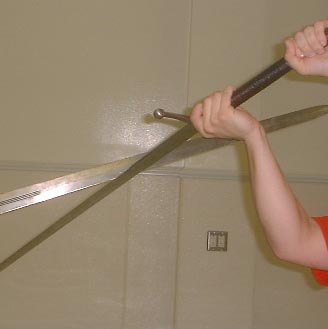 This
idea is nearly identical to Filippo Vadi’s own volarica
in the 1480s –a counter-cutting technique which he
called the “jewel of the art”.
This vertical downward cut to the head simultaneously
deflected the opponent’s own oncoming strike so that,
“in one time it hurts and parries”.
Vadi advised these strikes as among the most important
and stressed they required both timing and practice in order
to be used. This
timed-strike defense is a familiar action throughout Medieval
fencing literature. In a clear acknowledgement of
the difficulty some fencers have of using a downward counter-cut
as a simultaneous parry and riposte, Vadi said of the volarica:
“Hardly any understand who never did it” and that
it brought out the highest “banner of the art.”
It would appear
Master Vadi was correct; not much has changed today in that
regard. This
idea is nearly identical to Filippo Vadi’s own volarica
in the 1480s –a counter-cutting technique which he
called the “jewel of the art”.
This vertical downward cut to the head simultaneously
deflected the opponent’s own oncoming strike so that,
“in one time it hurts and parries”.
Vadi advised these strikes as among the most important
and stressed they required both timing and practice in order
to be used. This
timed-strike defense is a familiar action throughout Medieval
fencing literature. In a clear acknowledgement of
the difficulty some fencers have of using a downward counter-cut
as a simultaneous parry and riposte, Vadi said of the volarica:
“Hardly any understand who never did it” and that
it brought out the highest “banner of the art.”
It would appear
Master Vadi was correct; not much has changed today in that
regard.
Modern students of the craft need to understand that without practice
in the ability to deliver correct cuts –not whacking, clubbing hits, or soft,
exaggerated, out-of-range swings, but shearing blows with proper edge placement and
full-arm extension –they are not going to be able to parry by making intercepting
timed-strikes on the appropriate portion of the adversary’s oncoming blade. (This is yet another reason why in the ARMA we
stress realistic intent in our practice).
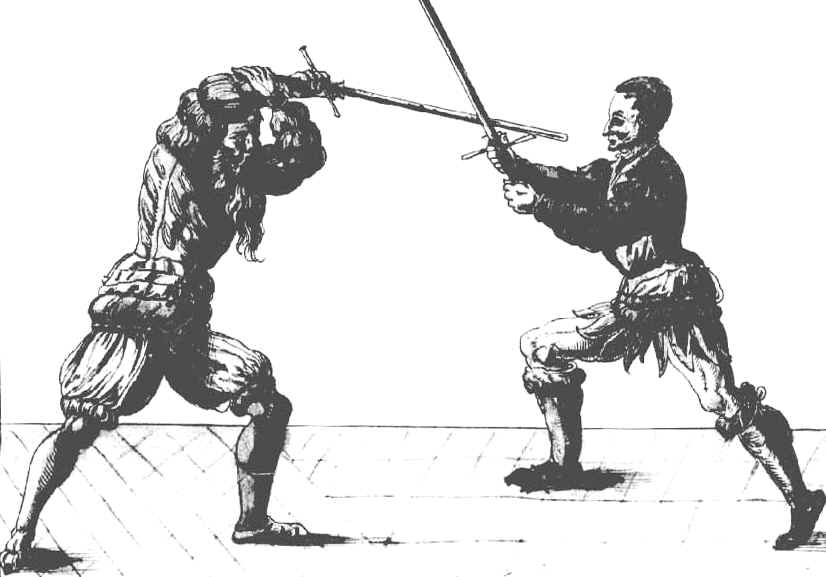 Most
tellingly however, is how Joachim Meyer also described in
his text a third form of defense, Auffangen or “Catching” (i.e., a direct static
block). According to Meyer, this was a
simple block wherein
the opponent’s attack –rather than ideally being
deflected off or struck down –was instead stopped by
directly interposing your weapon in its path.
Essentially an edge parry of desperation,
Meyer acknowledged it was sometimes necessary, yet he clearly
recognized that it conferred no particular advantage and even specifically recommended against doing it.
It is this very thing,
which he says not to do, that is so frequently employed
by unenlightened students of the longsword today. Most
tellingly however, is how Joachim Meyer also described in
his text a third form of defense, Auffangen or “Catching” (i.e., a direct static
block). According to Meyer, this was a
simple block wherein
the opponent’s attack –rather than ideally being
deflected off or struck down –was instead stopped by
directly interposing your weapon in its path.
Essentially an edge parry of desperation,
Meyer acknowledged it was sometimes necessary, yet he clearly
recognized that it conferred no particular advantage and even specifically recommended against doing it.
It is this very thing,
which he says not to do, that is so frequently employed
by unenlightened students of the longsword today.
Meyer, in his description of the Hengen (or
hanging point) technique, an action wherein the oncoming attack is deflected through the
rising motion of a cut, described how as “your adversary cuts at you, move up your
hilt, so that the blade hangs slightly to the ground, and receive his attack on the flat
of your blade”. Additionally, he
instructed, “Adopt Plow; as your
opponent strikes, lift your hilt to catch the blow with your flat.” As well, for the action of Verschieben he advised, “Adopt Wrath; when
your opponent strikes, lift your hilt over your head and catch the blow with your
flat.” If
edge parries were indeed valid and acceptable as a common way of parrying cuts with
cutting swords, we might surely expect that with a technique like the hanging guard they
would be advocated. Yet, here we have at
least two different texts specifically saying that the flat of the forte is used with the
hanging guard.
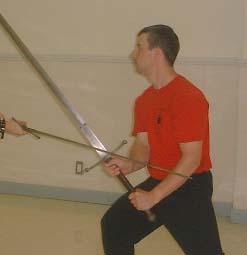 Joachim
Meyer ended his section on the long-sword by giving several
examples of exchanges of techniques between a student and
a master where he specifically cites use of the flat in
receiving or setting aside blows as well as striking them
down by hitting the opponent’s Starck (forte). Yet, Meyer never says to hit the
edge of the opponent's Starck (in
fact, doing so would actually allow
the opponent more resistance than if the counter
blow were thrown on his flat thereby forcing his wrist to turn).
These unequivocal examples clearly illustrate what
is meant today by the concept of “parrying with the
flat”. They
are the “smoking gun” of flat parries. Joachim
Meyer ended his section on the long-sword by giving several
examples of exchanges of techniques between a student and
a master where he specifically cites use of the flat in
receiving or setting aside blows as well as striking them
down by hitting the opponent’s Starck (forte). Yet, Meyer never says to hit the
edge of the opponent's Starck (in
fact, doing so would actually allow
the opponent more resistance than if the counter
blow were thrown on his flat thereby forcing his wrist to turn).
These unequivocal examples clearly illustrate what
is meant today by the concept of “parrying with the
flat”. They
are the “smoking gun” of flat parries.
Meyer’s manual also gives clear
examples of several techniques where an attacking strike
is received either on the ricasso or cross-guard while closing-in.
For example, in the Kronhaw
(“crown cut”) –a form of back-edge blow executed
from a high position –he teaches to catch the incoming
attack with your true edge with the ricasso: “Stand
in the Plow; as your opponent strikes from above, catch
him with the Crown; as it hits, push your pommel up to hit
him on the head with your false edge.” In the Glietzhaw,
or “Clashing Blow”,
he teaches to make a right to left counter-cut whereby
the right hand comes in pronated (knuckles up) to catch
an opponent’s oncoming strike on the flat. You then
immediately roll your blade counterclockwise and deliver
a false-edge blow. However, it should be understood that while Meyer’s
style did change somewhat from that of earlier schools,
his teachings on parrying with the long-sword were not new
at all and most go all the way back to Liechtenauer’s
in the late 14th century.
Another area that must be addressed
is that there are repeated instructions in the Medieval Fechtbuchs to “displace”
with either the long (forward) or short (back) edge.
But, as has been described previously, this form of displacement/parry is a
counter-strike, not a block and not a blow delivered against the adversary’s oncoming
edge.
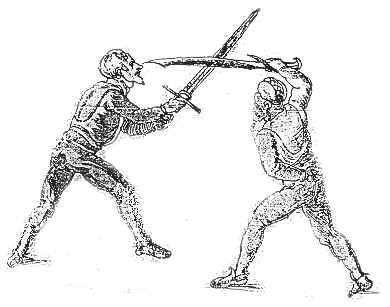 When instructions to “parry” with one
edge or another are seemingly given within the source manuals,
certain thoughts come to mind. The foremost being, that
such action consists of raising the sword into the path
of the incoming attack to thus obstruct and stop the oncoming
blade. Doing this would certainly result in the blades hitting
edge upon edge --obviously not a deflection. This would
be an incorrect interpretation. It assumes any instruction
to parry by using either the forward or else the back edge
means not only a blocking (rather than deflecting) action,
but that must somehow mean to also hit the opponent's blade
on their edge as well. Yet, there is no indication we
have found of this being the case in any manual and such
an interpretation would be inconsistent with all the other
teachings to simultaneously hit while parrying with one
action. Trying to deflect by intentionally using the sword-edge aimed at the opposing edge substantially
reduces the effectiveness of such an action. While blades
may contact at an almost infinite number of possible “angles”,
anything like a 90-degree sharp edge against sharp edge
obstruction is far from the most efficient. Whereas in comparison,
a parrying counter-blow that in one motion dynamically deflects
or counters the attacking blade by impacting upon its flat
is frequently able to continue on to strike. When instructions to “parry” with one
edge or another are seemingly given within the source manuals,
certain thoughts come to mind. The foremost being, that
such action consists of raising the sword into the path
of the incoming attack to thus obstruct and stop the oncoming
blade. Doing this would certainly result in the blades hitting
edge upon edge --obviously not a deflection. This would
be an incorrect interpretation. It assumes any instruction
to parry by using either the forward or else the back edge
means not only a blocking (rather than deflecting) action,
but that must somehow mean to also hit the opponent's blade
on their edge as well. Yet, there is no indication we
have found of this being the case in any manual and such
an interpretation would be inconsistent with all the other
teachings to simultaneously hit while parrying with one
action. Trying to deflect by intentionally using the sword-edge aimed at the opposing edge substantially
reduces the effectiveness of such an action. While blades
may contact at an almost infinite number of possible “angles”,
anything like a 90-degree sharp edge against sharp edge
obstruction is far from the most efficient. Whereas in comparison,
a parrying counter-blow that in one motion dynamically deflects
or counters the attacking blade by impacting upon its flat
is frequently able to continue on to strike.
In his
section on great-sword in his 1536 fencing text, Opera
Nova, the Bolognese master Achille Marozzo also gave
instruction to “parry” with either the true or
false edge. But with a careful reading it can be seen that
he means to counter-strike rather than defend by static
resistance and it must be pointed out he does not specify
which part of the opponent’s blade should be struck,
edge or flat. There does not seem to be any actual edge-to-edge
parry in his great-sword teachings. Instead, consistent
with earlier works, all his “parries” can be interpreted
as defensive actions to maintain the edge or point towards
the enemy so as to allow a riposte.
Marozzo also often uses the verb spingere,
which means “to push”, hardly a rigid type of
block. In fact,
many of Marozzo’s teachings for his light, single-hand,
cut-and-thrust, side-sword (spada di lato) only make
sense when we understand his counter-strikes are not “one,
two” movements but single actions that allow him to
simultaneously deflect and cut back.
Marozzo wrote that, “the art of striking is
but little in comparison with a knowledge of the parries,
which is a fine and more useful thing.”
But just being able to block would not be of much
use …unless of course his parries were also simultaneous
counterstrikes.
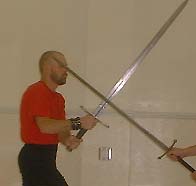 But
still other examples of flat parrying and counter-striking
defense can be found in the cutting swordplay of the 16th
century. For fighting with short tapering
cut-and-thrust swords there are two forms of defensive actions
or parries (parare/schivare) described in early 16th
century Italian fencing manuals. One defense is to intercept
and deflect an oncoming strike by hitting it with the true
or false edge against its forte –but the texts never
specify that the attacking blade be struck on its own edge
of the forte. The
other defense is to step into the oncoming strike and close
with it in order to greet and stifle its blow with your
own forte (just as found in Medieval longsword texts). But
in no way is this about holding a blade out to receive a
hit on its edge. The
parrying instructions found within these manuals, instructing
to counter-cut at the opponent’s blade in order to
deflect and intercept it, often get misinterpreted to mean
allowing them to hit your edge with their edge.
This problem may arise from trying to apply 18th
and 19th century methods of fencing with broadswords, sabers,
cutlasses, and spadroons to Renaissance weapons. Teaching
use of a light tapering short sword, Di Antonio Manciolino
in 1531 advised parries be accomplished as quick counterattacks
that should be done only with “the half of the sword
toward the hilt” (the forte of the blade) and using
the falso filo (the false or back edge). He further
stated they needed to also be done while advancing so that
contact is made against the forte of the adversary’s
forte. By moving forward in this way the oncoming
blow is met before it has speed and force.
But, as with other masters, he did not specify at
all that this counter-cut parry be on their blade’s
edge. But
still other examples of flat parrying and counter-striking
defense can be found in the cutting swordplay of the 16th
century. For fighting with short tapering
cut-and-thrust swords there are two forms of defensive actions
or parries (parare/schivare) described in early 16th
century Italian fencing manuals. One defense is to intercept
and deflect an oncoming strike by hitting it with the true
or false edge against its forte –but the texts never
specify that the attacking blade be struck on its own edge
of the forte. The
other defense is to step into the oncoming strike and close
with it in order to greet and stifle its blow with your
own forte (just as found in Medieval longsword texts). But
in no way is this about holding a blade out to receive a
hit on its edge. The
parrying instructions found within these manuals, instructing
to counter-cut at the opponent’s blade in order to
deflect and intercept it, often get misinterpreted to mean
allowing them to hit your edge with their edge.
This problem may arise from trying to apply 18th
and 19th century methods of fencing with broadswords, sabers,
cutlasses, and spadroons to Renaissance weapons. Teaching
use of a light tapering short sword, Di Antonio Manciolino
in 1531 advised parries be accomplished as quick counterattacks
that should be done only with “the half of the sword
toward the hilt” (the forte of the blade) and using
the falso filo (the false or back edge). He further
stated they needed to also be done while advancing so that
contact is made against the forte of the adversary’s
forte. By moving forward in this way the oncoming
blow is met before it has speed and force.
But, as with other masters, he did not specify at
all that this counter-cut parry be on their blade’s
edge.
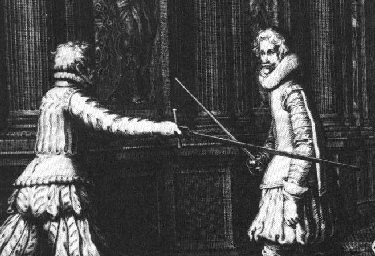 In
his 1570 fencing text, Giacomo Di Grassi stated that for
the two-hand sword, “It is a general rule, that the
true defense of all blows is the low ward.”
This makes sense when we consider it in light of
earlier Italian masters teaching parry by fendente
blows –all of which end in low wards. In 1579, Heinrich
Von Gunterrodt writing on the fencing method within a 12th
century German sword and buckler text (MS. I.33, later called
the Walpurgis
text), noted that ancient fencers “taught protections
of every blow or cut, which must be made with counterblows.”
Describing a method suited to any cut-and-thrust
sword, George Silver in his much later, Brief Instructions
Upon My Paradoxes of Defence, of 1599 wrote repeatedly of
“breaking” or “warding” of blows and
thrusts. Silver stated in his Rule 3 that:
“the warder has true space before the striker or thruster
is in force or entered into his action. Therefore always
do prevent both blow & thrust, the blow by true space,
& the thrust by narrow space, that is true crossing
it before the same come in to their full force…”.
By this he means a defender can step in to close
the distance against a cutting blow and stifle its force
before it is fully in motion, and to do this by opposing
(crossing) your sword against his –something ideally
done ricasso to ricasso.
Silver did not use the term “cross” to
mean blocking by literally forming a perpendicular intersection
with the two swords. In chapter 8 of George Silver’s
1599, Brief Instructions, he describes under Instruction
25, “Of the short sword & dagger fight
against the long sword & dagger or long rapier &
poniard” a parry that is completely familiar
from medieval manuals.
Silver, who nowhere in his works describes edge parries
or direct blocks, states: “if you ward his blow with
the edge of your sword your hand and knuckles as aforesaid,
casting out his sword blade towards your left side, this
may be used at short or long sword fight.” To ward
a blow in this manner as he describes is not a static parry
at all, but the usual method of striking away the opponent’s
blow with your edge on his flat.
It is no different from similar instructions by Achille
Marozzo some 60 years earlier. In
his 1570 fencing text, Giacomo Di Grassi stated that for
the two-hand sword, “It is a general rule, that the
true defense of all blows is the low ward.”
This makes sense when we consider it in light of
earlier Italian masters teaching parry by fendente
blows –all of which end in low wards. In 1579, Heinrich
Von Gunterrodt writing on the fencing method within a 12th
century German sword and buckler text (MS. I.33, later called
the Walpurgis
text), noted that ancient fencers “taught protections
of every blow or cut, which must be made with counterblows.”
Describing a method suited to any cut-and-thrust
sword, George Silver in his much later, Brief Instructions
Upon My Paradoxes of Defence, of 1599 wrote repeatedly of
“breaking” or “warding” of blows and
thrusts. Silver stated in his Rule 3 that:
“the warder has true space before the striker or thruster
is in force or entered into his action. Therefore always
do prevent both blow & thrust, the blow by true space,
& the thrust by narrow space, that is true crossing
it before the same come in to their full force…”.
By this he means a defender can step in to close
the distance against a cutting blow and stifle its force
before it is fully in motion, and to do this by opposing
(crossing) your sword against his –something ideally
done ricasso to ricasso.
Silver did not use the term “cross” to
mean blocking by literally forming a perpendicular intersection
with the two swords. In chapter 8 of George Silver’s
1599, Brief Instructions, he describes under Instruction
25, “Of the short sword & dagger fight
against the long sword & dagger or long rapier &
poniard” a parry that is completely familiar
from medieval manuals.
Silver, who nowhere in his works describes edge parries
or direct blocks, states: “if you ward his blow with
the edge of your sword your hand and knuckles as aforesaid,
casting out his sword blade towards your left side, this
may be used at short or long sword fight.” To ward
a blow in this manner as he describes is not a static parry
at all, but the usual method of striking away the opponent’s
blow with your edge on his flat.
It is no different from similar instructions by Achille
Marozzo some 60 years earlier.
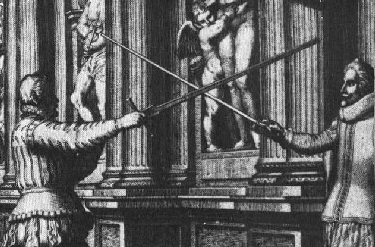 In
his 1617 backsword and rapier fencing text swordsman Joseph
Swetnam also makes no mention of the word “block”
or “parry”, but only talks of defending and receiving
blows. In Chapter
XII of his, Schoole
of the Noble and Worthy Science of Defence he
“Showeth of seven principal rules whereon true
defence is grounded” which states succinctly the principal
of counter-striking over blocking: “thou must defend
and seeke to offend all at once, for thou must not suffer
thy enemy to recover his guard, for if thou doe thou looseth
thy advantage.” (p. 74). In referring to the “true guard for
the defence, either of blowe, or thrust, with Rapier and
Dagger”, Swetnam just
as with other masters, advised to use its edge to parry
–since, the true rapier being a narrow
rigid blade with little edge, can do this.
Swetnam wrote: “Carrie the edge of thy rapier
upward, and downward, for then thou shalt defend a blow
upon the edge of thy rapier, by bearing thy rapier after
the rule of the Backe-sword, for this is the strongest and
surest carriage of him.” (Swetnam, p. 86). This “rule of the backsword”
that Swetnam refers to bares explanation.
Just what it is he never explains or addresses.
But common sense tells us there must be some reason
why he specifically refers to a parrying rule for the “back”
sword and not simply a rule for “a sword” or “all
swords”. What
is it that is special about a backsword?
It has a back. Unlike double-edged swords it
has one side that is thicker and dull and not used for striking
cuts (…similar to a rapier). Thus, it can be used for
parrying and likely was employed in this manner similarly
to later cutlasses and sabers. In
his 1617 backsword and rapier fencing text swordsman Joseph
Swetnam also makes no mention of the word “block”
or “parry”, but only talks of defending and receiving
blows. In Chapter
XII of his, Schoole
of the Noble and Worthy Science of Defence he
“Showeth of seven principal rules whereon true
defence is grounded” which states succinctly the principal
of counter-striking over blocking: “thou must defend
and seeke to offend all at once, for thou must not suffer
thy enemy to recover his guard, for if thou doe thou looseth
thy advantage.” (p. 74). In referring to the “true guard for
the defence, either of blowe, or thrust, with Rapier and
Dagger”, Swetnam just
as with other masters, advised to use its edge to parry
–since, the true rapier being a narrow
rigid blade with little edge, can do this.
Swetnam wrote: “Carrie the edge of thy rapier
upward, and downward, for then thou shalt defend a blow
upon the edge of thy rapier, by bearing thy rapier after
the rule of the Backe-sword, for this is the strongest and
surest carriage of him.” (Swetnam, p. 86). This “rule of the backsword”
that Swetnam refers to bares explanation.
Just what it is he never explains or addresses.
But common sense tells us there must be some reason
why he specifically refers to a parrying rule for the “back”
sword and not simply a rule for “a sword” or “all
swords”. What
is it that is special about a backsword?
It has a back. Unlike double-edged swords it
has one side that is thicker and dull and not used for striking
cuts (…similar to a rapier). Thus, it can be used for
parrying and likely was employed in this manner similarly
to later cutlasses and sabers.
For
example, we can consider
that
Alfred
Hutton in
his 1889 treatise, Cold
Steel,
on the use of the sabre (based
on 18th
century backswording ‘combined’
with the method of Italian foil), advised the following
in regard to parrying: “Cut
2 at the right cheek is parried by tierce or sixte, in the later case the blow is received
on the back of the sword” (p. 34). He also added, “From
the guard in sixte, drop the point in octave and receive
on the back of the sword”
(p. 37).
A proper understanding of parrying with Medieval longswords can thus
give a different take on just what later 16th century fencing writers were
really saying on the subject of defending against cuts with a cutting blade.
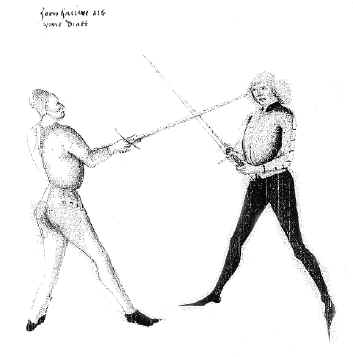 As
I’ve addressed before, a last area of confusion is
that much of the artwork within Medieval longsword manuals
can appear to the untrained eye to be two fighters with
their weapons crossed or in opposition, one “blocking”
the other. When in fact, the case is invariably
that one fighter has attacked and the other is shown in
the midst of executing his counterstrike. At other times, one fighter has
stepped in and shortened the range in order to close with
the adversary, thereby stifling any strike before
it has fully committed.
In this case, it is something that is indeed done
with the edge of the sword precisely because it prevents
rather than meets a full thrown blow head-on.
For this very reason sword edges at the ricasso
were often made extra thick. There
are numerous times in Medieval swordplay where pressing
edge to edge is used in this way (or even to control the
adversary's blade any time you are pressing against it),
but these should not be confused with actual parries of
forceful cuts. One such technique like this is the Kron,
where the fighter steps into the attack and raises his ricasso
to intercept and receive the opponent’s downward cut
on his edge near the cross guard. Master Fiore described a counter
of this type by stating how “my sword that has received
a blow …with the pommel I hurt you in the face”.
In other words, he lifted his blade as he stepped
in and closed the distance to stop the blow early and was
immediately in range to hit.
But like other masters, he never considered such
an action as a parare’, let alone one of sharp
edge upon sharp edge. As
I’ve addressed before, a last area of confusion is
that much of the artwork within Medieval longsword manuals
can appear to the untrained eye to be two fighters with
their weapons crossed or in opposition, one “blocking”
the other. When in fact, the case is invariably
that one fighter has attacked and the other is shown in
the midst of executing his counterstrike. At other times, one fighter has
stepped in and shortened the range in order to close with
the adversary, thereby stifling any strike before
it has fully committed.
In this case, it is something that is indeed done
with the edge of the sword precisely because it prevents
rather than meets a full thrown blow head-on.
For this very reason sword edges at the ricasso
were often made extra thick. There
are numerous times in Medieval swordplay where pressing
edge to edge is used in this way (or even to control the
adversary's blade any time you are pressing against it),
but these should not be confused with actual parries of
forceful cuts. One such technique like this is the Kron,
where the fighter steps into the attack and raises his ricasso
to intercept and receive the opponent’s downward cut
on his edge near the cross guard. Master Fiore described a counter
of this type by stating how “my sword that has received
a blow …with the pommel I hurt you in the face”.
In other words, he lifted his blade as he stepped
in and closed the distance to stop the blow early and was
immediately in range to hit.
But like other masters, he never considered such
an action as a parare’, let alone one of sharp
edge upon sharp edge.
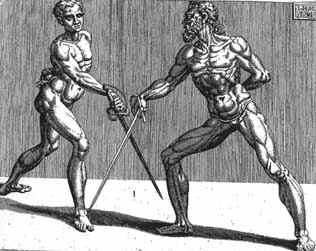 Finally,
it’s important to understand, swords are valuable and
sharp edges are fragile, and you don’t and can’t
slam two thin, sharp edges together without severely damaging
them. It's
simple physics and there is no escaping it. Perhaps
it’s something that is not fully appreciated by enthusiasts
today until you've tried it yourself using sharp edges on
accurate replicas to see how easily the edges are horrendously
gouged and ruined. After too much of this they will
cut very poorly. There are in fact a good number of accounts
within historical literature describing this very phenomenon
as something bad to be avoided since it destroys fine swords. Sword expert Hank Reinhardt adds,
“If you still can’t understand why a [cutting]
sword uses its flat to block, simply go take two large,
sharp hunting knives and bang them together full-force on
each other’s edge and you’ll quickly see why.”
Not surprisingly, the respected modern Italian replica-sword
maker, Fulvio Del Tin, offered this on the subject:
“…It is improper to bang swords edge to
edge…it is better to deflect the opponent’s sword. These people that perform swordfighting in the wrong way…they
use swords with full strength edge to edge…I wish that
in (the) future many people (will) learn how to do swordfighting
correctly, instead of imitating Hollywood heroes.” Finally,
it’s important to understand, swords are valuable and
sharp edges are fragile, and you don’t and can’t
slam two thin, sharp edges together without severely damaging
them. It's
simple physics and there is no escaping it. Perhaps
it’s something that is not fully appreciated by enthusiasts
today until you've tried it yourself using sharp edges on
accurate replicas to see how easily the edges are horrendously
gouged and ruined. After too much of this they will
cut very poorly. There are in fact a good number of accounts
within historical literature describing this very phenomenon
as something bad to be avoided since it destroys fine swords. Sword expert Hank Reinhardt adds,
“If you still can’t understand why a [cutting]
sword uses its flat to block, simply go take two large,
sharp hunting knives and bang them together full-force on
each other’s edge and you’ll quickly see why.”
Not surprisingly, the respected modern Italian replica-sword
maker, Fulvio Del Tin, offered this on the subject:
“…It is improper to bang swords edge to
edge…it is better to deflect the opponent’s sword. These people that perform swordfighting in the wrong way…they
use swords with full strength edge to edge…I wish that
in (the) future many people (will) learn how to do swordfighting
correctly, instead of imitating Hollywood heroes.”
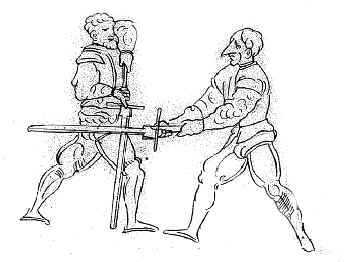 As
can be seen, this is a complex subject –which explains
why modern language composite explanations are often useful.
Even a brief outline of parrying in Medieval swordplay such
as this can barely avoid having to also begin discussing
attacks and basic fighting techniques as well as footwork
and stances. This makes the issue of parrying
edge or flat a much more complex one than simply saying,
don’t do it because it unnecessarily damages your weapon,
or is inferior to more efficient methods of counterstriking
that don’t leave you exposed. As
can be seen, this is a complex subject –which explains
why modern language composite explanations are often useful.
Even a brief outline of parrying in Medieval swordplay such
as this can barely avoid having to also begin discussing
attacks and basic fighting techniques as well as footwork
and stances. This makes the issue of parrying
edge or flat a much more complex one than simply saying,
don’t do it because it unnecessarily damages your weapon,
or is inferior to more efficient methods of counterstriking
that don’t leave you exposed.
Finally, consider that while the details of the descriptions
above may change as we acquire clearer translations of the
source manuals or amend our interpretations with new insights,
the essential core of ideas remain the same: Parries are
done by counter-blow deflection or close interception, either
edge on flat or flat on edge. There’s no special “wrist
turning” involved to use a cutting sword’s flat
side in parrying nor do cutting-swords “wobble”
or bend when defending in this way.
Indeed, it could be persuasively argued that when
proficiently using the correct guards and defensive counter-blows
as described within Medieval fighting manuals, it isn’t
even possible to deliberately and consistently use a sword’s
edge for static blocks (–at least not without actively
going out of the way to expose yourself to counter-attacks
as well as losing the opportunity for efficient ripostes).
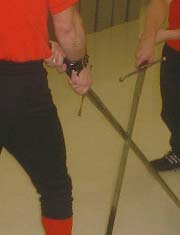 If
a student still doubts that the flat of a Medieval sword
was used for receiving blows, it is suggested they try to
make a half-sword block by using the edge against a full-force,
full speed attack. They will injure their palm in the attempt. But tried with the flat of the
blade they will easily deflect the attacking blow.
If a student doubts that a strong cut can be displaced
by another cut thrown a split-second afterwards so that
it knocks the other blade away and hits back, they just
need to practice harder and longer. But, without
opportunity to offer instruction in sword defense to students
in person, all that can be really done is to document the
evidence until the coffin of the edge-parry myth with Medieval
longswords is hermetically sealed and a stake driven through
this undead horse. If
a student still doubts that the flat of a Medieval sword
was used for receiving blows, it is suggested they try to
make a half-sword block by using the edge against a full-force,
full speed attack. They will injure their palm in the attempt. But tried with the flat of the
blade they will easily deflect the attacking blow.
If a student doubts that a strong cut can be displaced
by another cut thrown a split-second afterwards so that
it knocks the other blade away and hits back, they just
need to practice harder and longer. But, without
opportunity to offer instruction in sword defense to students
in person, all that can be really done is to document the
evidence until the coffin of the edge-parry myth with Medieval
longswords is hermetically sealed and a stake driven through
this undead horse.
While we continue to look and to revise findings, we’ve found
nothing so far in our research and interpretation that supports edge blocking of strong
cuts for the use of cutting blades in Medieval and early Renaissance fighting. There is no
technique we can find that cannot be performed as a strike edge on flat or flat on edge or
as an Einlauffen (closing and pressing) with the forte / edge of the ricasso.
It’s been said, you can never really “disprove” something. In this case,
the existence of counter-striking defense and flat parrying is not in question. The burden
of proof is on those making a claim for edge parrying as a viable action of the historical
methods. Unless unequivocal, undeniable proof from the source manuals can be presented for
blocking a strong cut with the edge of a cutting sword, I think in light of the evidence,
specifically Meyer’s clear statement not to use Auffangen, it pretty much closes the
case
As the various terms for
parries and concepts of defensive actions within Medieval swordplay can become confusing
to enthusiasts, many practitioners start to ask where are the blocks we see in the movies
or we learn in modern fencing? The fact is,
they aren’t there! In their place is
something better, something more ingenious, at once more sophisticated and yet far
simpler…and therein lies its beauty. In conclusion, I offer the advice that students
keep in mind one obvious truth about longswords: The edge is the sharp part for inflicting
cuts and delivering blows, not for blocking.
END NOTE: In
a new book on historical fencing (due in late 2002) I include an extensive 45-page article
(at last count with 109 footnotes) documenting the evidence from the historical source
manuals and literature for parrying by counter-striking or flat blocking. The preceding material was taken from that larger
in-depth article.
© Copyright 2002 by
John Clements.
See
also:
On The Edge Of
Knowledge - Parrying With A Cutting Sword
and
On Parrying:
Go
to Part I, Go
to Part II, Go
to Part III
|

